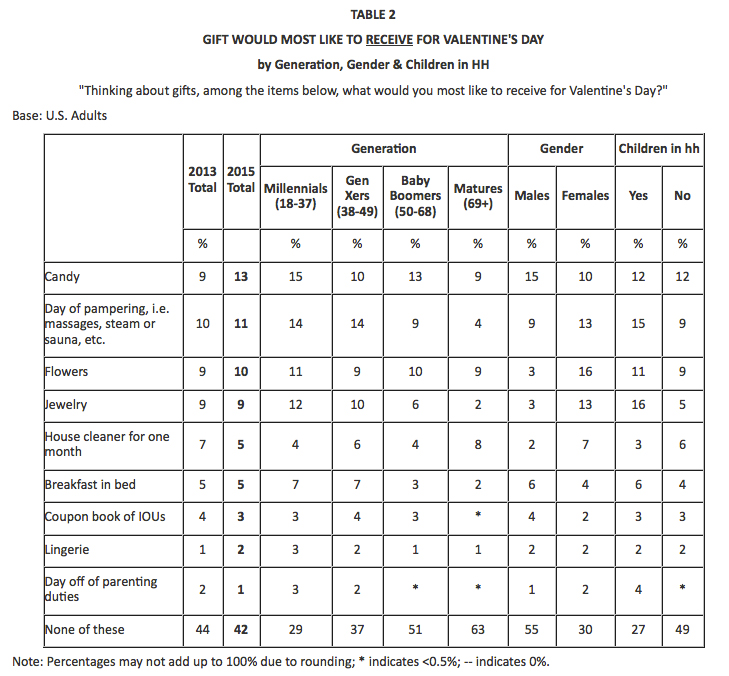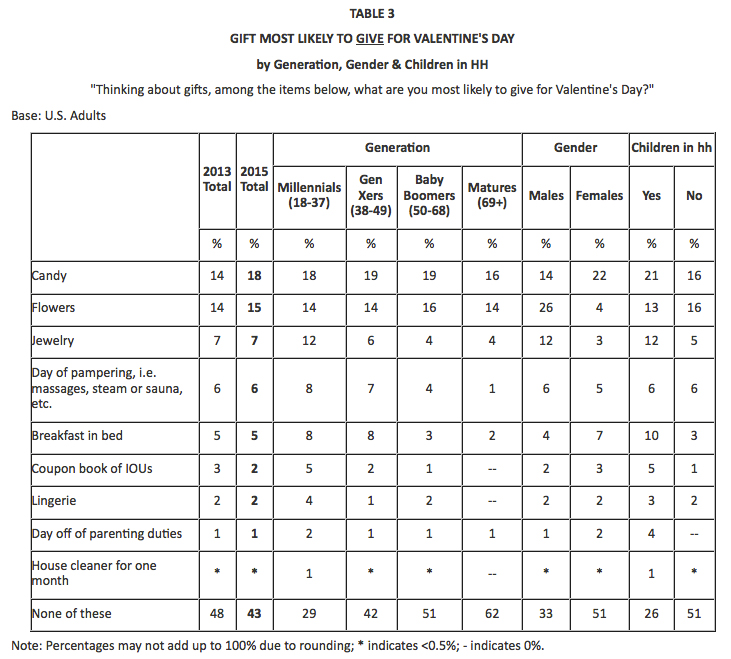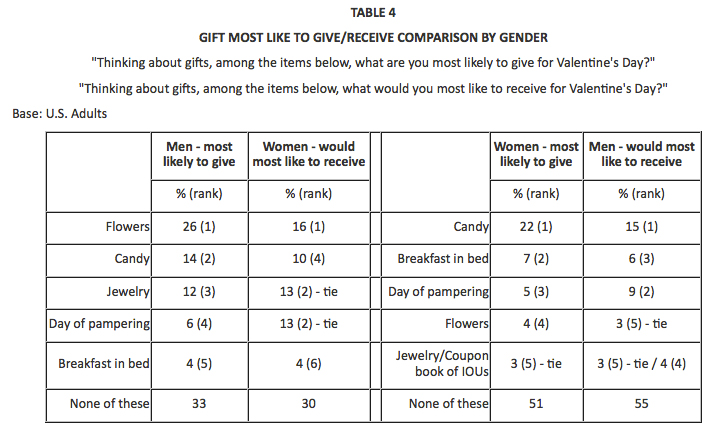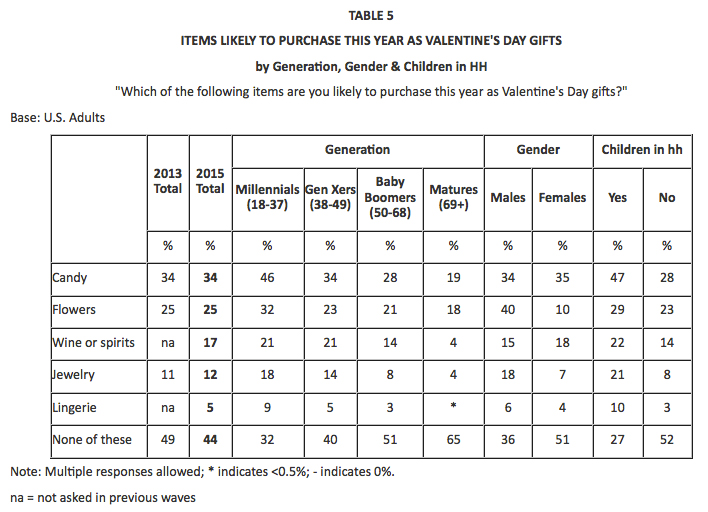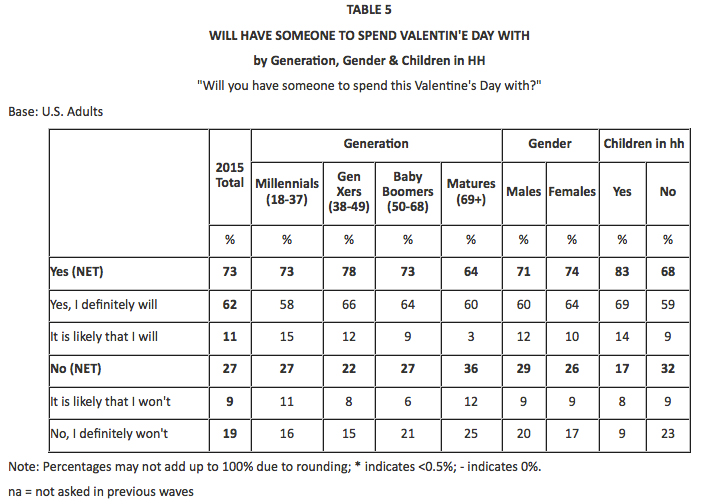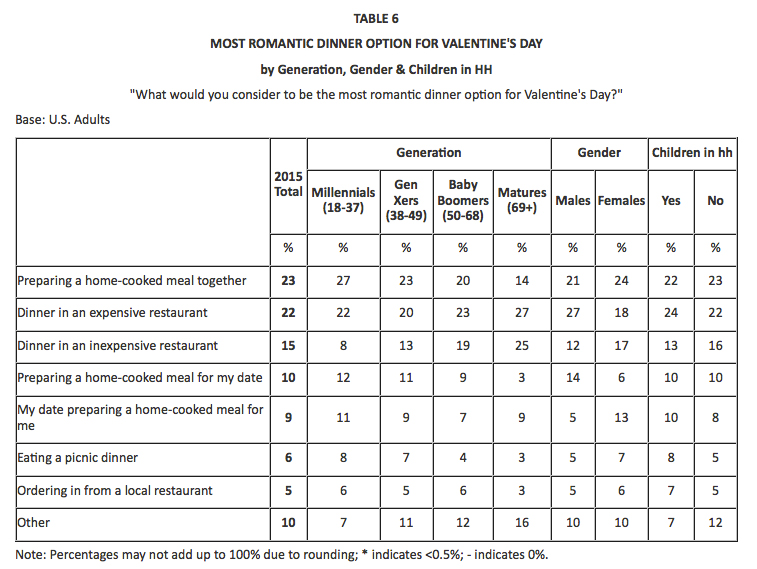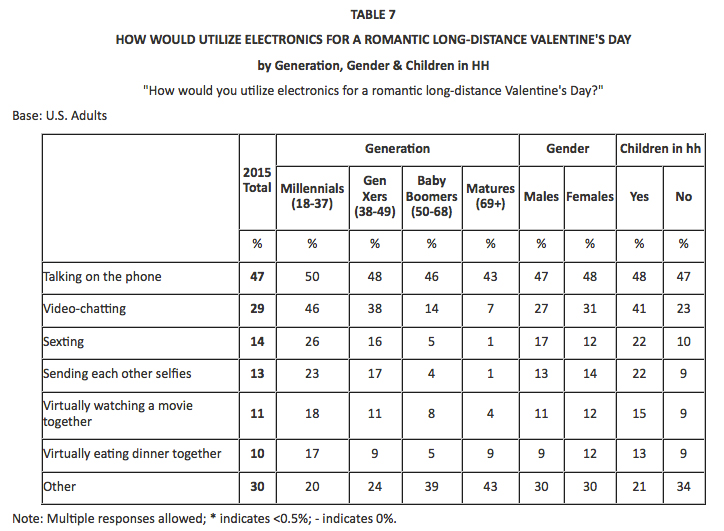Valentine’s Day Attitudes [INSIGHT]
February 14, 2015
 Depending on who you’re talking to at the time, it could be that you’ve heard February 14th is a great time of year to make that special someone understand just how much they mean to you… or that it’s an overly merchandized cog in an insidious corporate machine bent on monetizing as many days of the year as possible. While certainly many opinions fall between these two extremes, those tend to be the most broadly expressed views on Valentine’s Day. Findings from a recent Harris Poll certainly show a data point or two for each camp to call their own. On the one hand, roughly half of Americans (48%) look at Valentine’s Day as an opportunity to communicate more with their significant other. On the other hand, about two-thirds each say the consumerism of the holiday has ruined the romance (66%) and view the time-honored tradition of Valentine’s Day marriage proposals as cliché (68%).
Depending on who you’re talking to at the time, it could be that you’ve heard February 14th is a great time of year to make that special someone understand just how much they mean to you… or that it’s an overly merchandized cog in an insidious corporate machine bent on monetizing as many days of the year as possible. While certainly many opinions fall between these two extremes, those tend to be the most broadly expressed views on Valentine’s Day. Findings from a recent Harris Poll certainly show a data point or two for each camp to call their own. On the one hand, roughly half of Americans (48%) look at Valentine’s Day as an opportunity to communicate more with their significant other. On the other hand, about two-thirds each say the consumerism of the holiday has ruined the romance (66%) and view the time-honored tradition of Valentine’s Day marriage proposals as cliché (68%).
But of course, the holiday might not be worth of such commercializing in the first place if people weren’t celebrating it. So what are Americans getting each other? What’s their ideal romantic dinner? And in what ways might they consider technologically supplementing their Valentine’s Day plans?
These are some of the results of The Harris Poll® of 2,232 U.S. adults surveyed online between January 14 and 19, 2015.
Giving and getting
Attitudes aside, what are people actually shopping for this Valentine’s Day? And what do they actually want? In some areas women and men appear to be on the same page, while in others they seem to be missing one another. Flowers come in as the No. 1 gift women would most like to receive for Valentine’s Day, and men appear up to the task as it is also the No. 1 gift they’re likely to give. Women are similarly on target, as candy is the top mention among both gifts they’re likely to give and gifts men would like to receive. As the list moves on though, men and women alike may veer off course a bit.
- Candy ranks second as the gift men are most likely to give, whereas jewelry and a day of pampering tie for the No. 2 spot among gifts women would like to receive (these ranked third and fourth, respectively, among gifts men are likely to give). Where does Candy actually rank among women’s preferences? In the No. 4 spot.
- Women are a bit more on target. Their second likeliest gift, breakfast in bed, ranks as men’s third most wanted; the inverse is true for a day of pampering, which ranks as the third most likely gift for women to give but as men’s second most desired present.
Ranking notwithstanding, roughly a third of Americans (34%) say they’re likely to purchase candy this year as Valentine’s Day gifts while a quarter (25%) are likely to purchase flowers. Just under two in ten (17%) are likely to purchase wine or spirits, while just over one in ten (12%) anticipate buying jewelry, and 5% say they’re likely to purchase lingerie.
But when Americans look back on the best and worst presents they’ve received on Valentine’s Day, some patterns emerge, each with a lesson for those paying attention:
- Lesson 1 – Read the room. Many of the open ended “worst” gift responses stem from a fundamental failure to take the recipient into account. Cases in point include “Candy while dieting,” “Earrings when I don’t have pierced ears,” “A shirt in my least favorite color,” “Flowers I was allergic to,” and “Caramels – I hate them.”
- Lesson 2 – Execution counts. Not-so-fresh (or even missing!) flowers, cheap or low quality candy and internet greeting cards all appeared among the least-loved gifts. On the other hand, there are some telltale words among the favorites which should give you an idea of how to set your gift apart. ” Fancy chocolates.” “My favorite candy.” And above all, a little elbow grease can go a long way. Whether in relation to cards, meals, or even short erotic novels, the words “homemade” and “handmade” made frequent appearances on the best-of list.
- Lesson 3 – Sometimes being present is present enough. Being distant from a loved one was another recurring theme on the least-faves list, whether due to business travel, military deployment, or more emotional forms of distance, including inebriated partners or those forgetting the holiday entirely. On the other end of the spectrum, surprise visits from loved ones made several Americans’ favorite gift lists, as did simply being with a loved one; some examples of statements along these lines include “My partner’s undivided attention” and “Wake up next to her.”
Lessons and learnings aside, we’d be remiss to overlook the volume of responses on both the “best” and “worst” lists revolving around more… intimate gifts (or lack thereof, in the case of the “worst gifts” list).
Table for two
A romantic meal is a longtime Valentine’s Day staple, but there’s some dissent as to what makes a meal romantic. When presented with several options and asked which they would consider to be the most romantic dinner option for Valentine’s Day, nearly even percentages opt for the togetherness of preparing a home-cooked meal together (23%) and the indulgence of dinner in an expensive restaurant (22%). Fifteen percent point to dinner at an inexpensive restaurant, while roughly one in ten each select either preparing a home-cooked meal for their date (10%) or having a home-cooked meal prepared for them by a date (9%).
- Dinner at an expensive restaurant is the top choice among men (27% vs. 18% among women), while preparing a home-cooked meal together is the top selection among women (24% vs. 21% among men).
Bridging the digital distance
And what of the role of electronics in bringing couples closer together? When asked how they would utilize electronics for a romantic long-distance Valentine’s Day, nearly half indicate talking on the phone as an option (47%), while three in ten Americans (29%) and nearly half of Millennials (46%) point to video-chatting. 14% of U.S. adults and a fourth of Millennials (26%) indicate they’d turn to sexting, while similar percentages (13% Americans, 23% Millennials) indicate they’d send each other selfies. Roughly one in ten Americans and nearly two in ten Millennials indicate they’d virtually watch a movie together (11% Americans, 18% Millennials) and virtually enjoy eating dinner together (10% and 17%, respectively).

